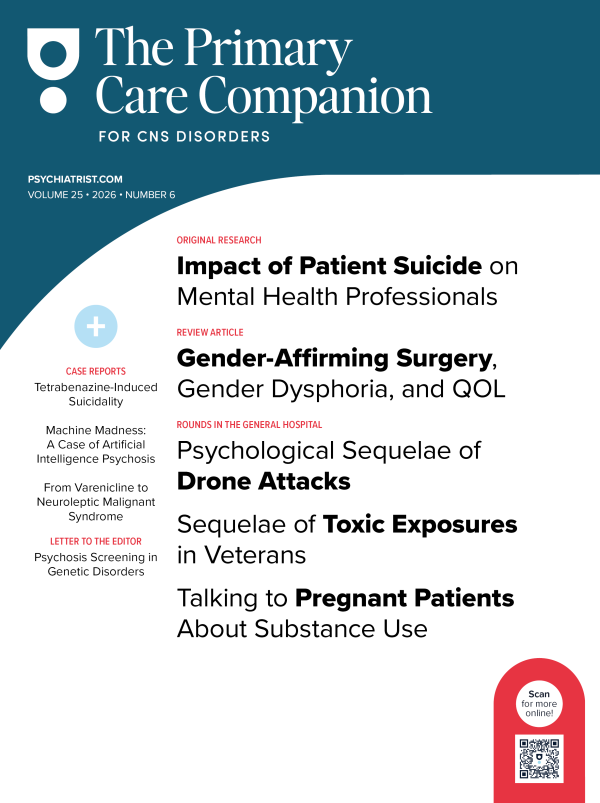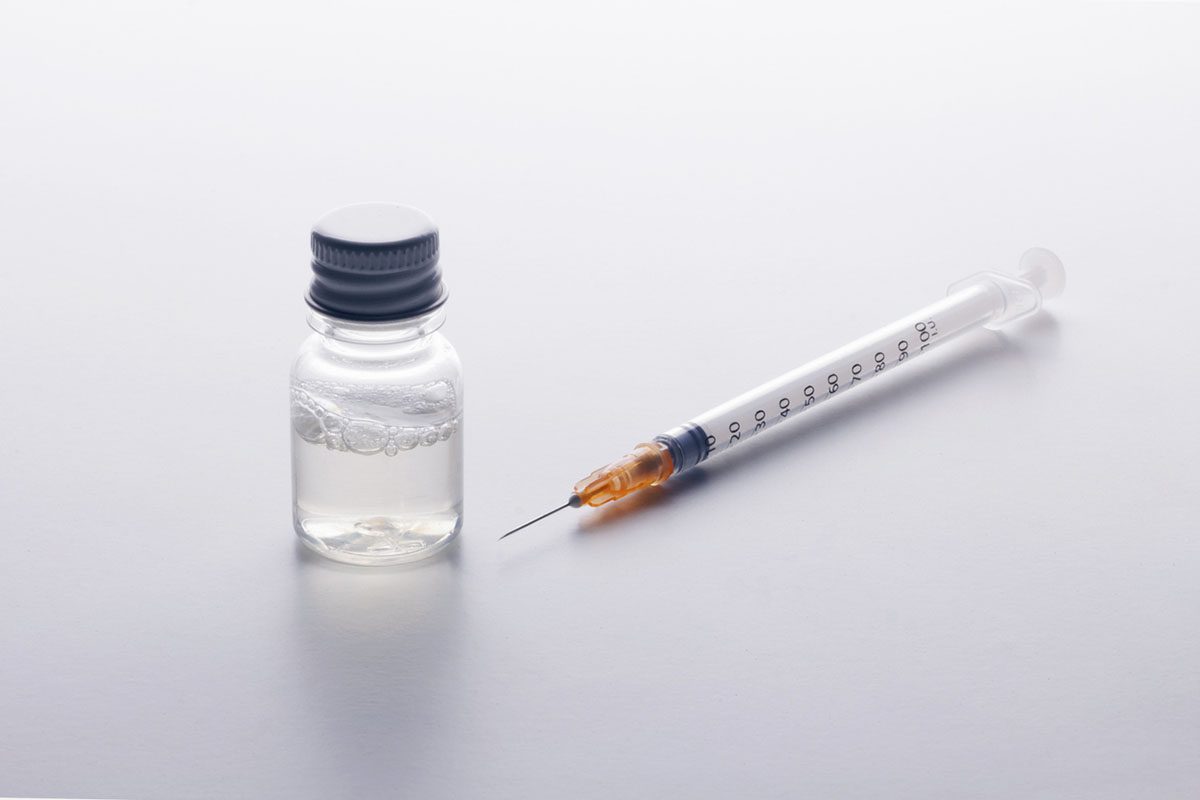Abuse of Combinations of Gabapentin and Quetiapine
To the Editor: Medications may be misused, particularly if they produce sedative or anxiolytic effects. We describe misuse of combinations of gabapentin and quetiapine.
Case report. A 42-year-old man was admitted to a treatment program after his second arrest for driving under the influence of an unknown substance. He had used marijuana and cocaine but stopped after obtaining employment requiring drug testing. Afterward, he had negative drug screens but sometimes appeared "stoned." He had prescriptions for quetiapine and gabapentin and misused these 2 medications together to replace the drugs he had taken. Taking up to 5 tablets of gabapentin 300 mg with 3 to 4 tablets of quetiapine 200 mg simultaneously produced a sensation of sedation and euphoria.
His girlfriend was prescribed and also misused gabapentin with quetiapine when she could not afford cocaine, taking 3 to 4 tablets of gabapentin 300 mg with 2 to 3 tablets of quetiapine 200 mg, sometimes with beer. She described similar, although weaker, effects. The couple was acquainted with 3 others who misused the same combination by taking 400-800 mg of quetiapine with 900-1,800 mg of gabapentin. Prescriptions were reportedly obtained by fabrication or exaggeration of symptoms. Tablets were sometimes sold or traded for illicit drugs.
Evidence exists for abuse of both gabapentin and quetiapine. Both have been removed from several prison formularies because of abuse by inmates. A woman substituted gabapentin 600-1,500 mg daily for cocaine.1 Florida inmates admitted snorting gabapentin powder for effects reminiscent of cocaine.2 Benzodiazepine-like withdrawal and dependence have been described.3,4 Gabapentin has been misused to potentiate the effect of methadone.5 About 20 cases of gabapentin addiction have been described in Europe.6 There are several reports of oral quetiapine abuse (800-1,200 mg at a time) for sedating and anxiolytic effects.7 Quetiapine powder is sometimes snorted intranasally8; intravenous abuse has also occurred.9 Drug-seeking behavior, compulsive use, diversion, dependence, and withdrawal have been described.10,11 Quetiapine is sometimes called "quell" or "baby heroin" by inmates.
Gabapentin inhibits voltage-gated calcium channels and entails an increase in γ-aminobutyric acid neurotransmission, as well as modulation of excitatory amino acids at N-methyl-d-aspartate receptor sites.4 Quetiapine acts as an antagonist at serotonin 5-HT1A and 5-HT2A, dopamine D1 and D2, histamine H1, and adrenergic α1 and α2 receptors.7 With the 2 drugs combined, many neuroreceptors are affected, and effects at high doses could be significant. Toxicity may exist for patients taking large amounts of gabapentin and/or quetiapine. Clinicians should exercise vigilance when using either to treat patients who use alcohol or illicit drugs, particularly if gabapentin and quetiapine are prescribed concomitantly.
References
1. Markowitz JS, Finkenbine R, Myrick H, et al. Gabapentin abuse in a cocaine user: implications for treatment? J Clin Psychopharmacol. 1997;17(5):423-424. PubMed doi:10.1097/00004714-199710000-00012
2. Reccoppa L, Malcolm R, Ware M. Gabapentin abuse in inmates with prior history of cocaine dependence. Am J Addict. 2004;13(3):321-323. PubMed doi:10.1080/10550490490460300
3. Hellwig TR, Hammerquist R, Termaat J. Withdrawal symptoms after gabapentin discontinuation. Am J Health Syst Pharm. 2010;67(11):910-912. PubMed doi:10.2146/ajhp090313
4. Kruszewski SP, Paczynski RP, Kahn DA. Gabapentin-induced delirium and dependence. J Psychiatr Pract. 2009;15(4):314-319. PubMed doi:10.1097/01.pra.0000358318.73684.df
5. Baird CR, Fox P, Colvin LA. Gabapentenoid abuse in order to potentiate the effect of methadone: a survey among substance misusers. Eur Addict Res. 2013;20(3):115-118. PubMed doi:10.1159/000355268
6. Gabapentin and pregabalin: abuse and addiction. Prescrire Int. 2012;21(128):152-154. PubMed
7. Reeves RR, Brister JC. Additional evidence of the abuse potential of quetiapine. South Med J. 2007;100(8):834-836. PubMed doi:10.1097/SMJ.0b013e3180f62d53
8. Pierre JM, Shnayder I, Wirshing DA, et al. Intranasal quetiapine abuse. Am J Psychiatry. 2004;161(9):1718. PubMed doi:10.1176/appi.ajp.161.9.1718
9. Hussain MZ, Waheed W, Hussain S. Intravenous quetiapine abuse. Am J Psychiatry. 2005;162(9):1755-1756. PubMed doi:10.1176/appi.ajp.162.9.1755-a
10. Murphy D, Bailey K, Stone M, et al. Addictive potential of quetiapine. Am J Psychiatry. 2008;165(7):918. PubMed doi:10.1176/appi.ajp.2008.08020277
11. Yargic I, Caferov C. Quetiapine dependence and withdrawal: a case report. Subst Abus. 2011;32(3):168-169. PubMed doi:10.1080/08897077.2011.558448
Author affiliations: Mental Health Service, G.V. (Sonny) Montgomery VA Medical Center; and Department of Psychiatry, University of Mississippi School of Medicine, Jackson, Mississippi.
Potential conflicts of interest: None reported.
Funding/support: None reported.
Published online: September 11, 2014.
Prim Care Companion CNS Disord 2014;16(5):doi:10.4088/PCC.14l01660
© Copyright 2014 Physicians Postgraduate Press, Inc.





